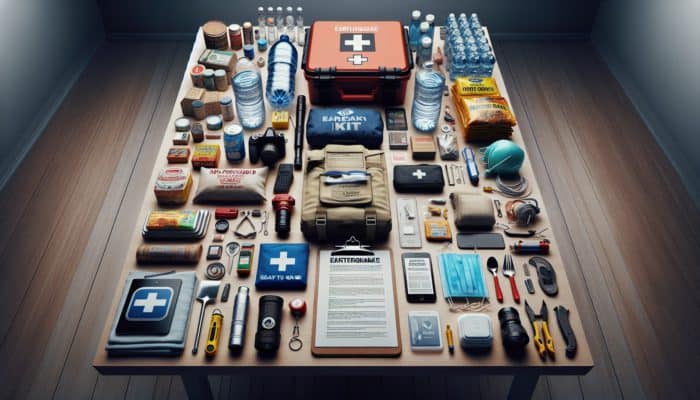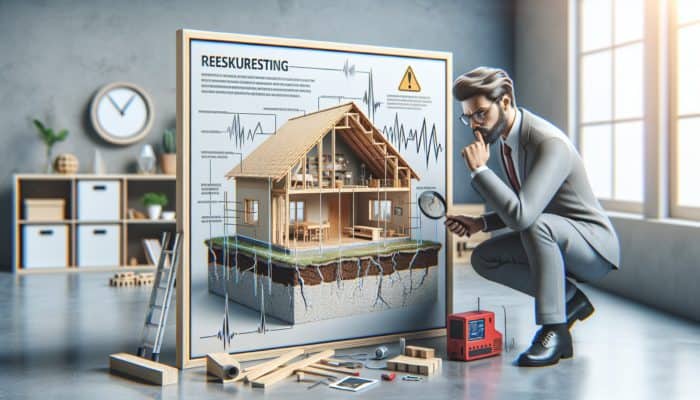Comprehending the Risks Associated with Earthquakes
What Are the Primary Causes of Earthquakes?

Preparing for Earthquakes: Earthquakes predominantly arise from the dynamic movements of tectonic plates, which are colossal sections of the Earth's crust that rest upon the semi-plastic mantle beneath. These tectonic plates can collide, separate, or slide against one another, generating friction that accumulates energy. Once this stored energy is finally unleashed, it manifests as seismic waves that cause the ground to tremble. Grasping the intricacies of these geological processes is essential for accurately predicting and preparing for seismic events. Common factors that trigger earthquakes include:
- Plate tectonic movements
- Volcanic activity
- Human activities (including mining and reservoir-induced seismicity)
- Fault lines slipping
- Land subsidence or sinking
- Stress build-up in the Earth's crust
- Aftershocks following previous earthquakes
Being cognizant of these triggers can significantly enhance community preparedness and bolster individual safety.
How to Assess Your Home’s Vulnerability to Earthquakes
Evaluating your living environment for potential risks is a vital step in ensuring earthquake preparedness. Unchecked vulnerabilities can lead to serious injuries or substantial property damage during an earthquake. Start by pinpointing heavy furniture and unsecured items that could turn into dangerous projectiles. Key areas to scrutinise include:
- Bookcases and shelves
- Heavy appliances such as refrigerators and washing machines
- Mirrors and picture frames
- Hanging plants and light fixtures
- Windows and sliding glass doors
- Garage items and tools
- Outdoor structures like patios or balconies
By securing these items, you can significantly mitigate the risk of injury and damage. Begin by anchoring tall furniture to the wall and utilising safety straps for heavy appliances. This proactive evaluation not only safeguards your home but also ensures a safer environment for all residents.
Why Early Warning Systems Are Essential for Earthquake Preparedness
Early warning systems serve as crucial instruments in earthquake preparedness, offering invaluable seconds or even minutes of lead time before tremors strike. These critical moments can be life-saving, enabling individuals to take cover, shut off gas lines, or evacuate if needed. Numerous regions globally are investing in sophisticated seismic networks that track tectonic movements and can dispatch alerts to mobile devices or emergency systems. The effectiveness of these systems significantly bolsters community readiness and individual response capabilities. Furthermore, public education regarding these alerts is imperative; understanding how to react when an alert is received can further reduce risks during an earthquake.
How to Prepare a Comprehensive Earthquake Emergency Kit

Putting together a thoroughly stocked emergency kit is a pivotal aspect of earthquake preparedness. A well-equipped kit ensures that you are ready to meet immediate needs following a seismic incident. Essential items to include are:
- At least one gallon of water per person per day for three days
- Non-perishable food items sufficient for three days
- A flashlight with extra batteries
- A first aid kit
- A whistle to signal for help
- A dust mask to help filter contaminated air
- Moist towelettes, garbage bags, and plastic ties for personal sanitation
- A multi-tool or Swiss Army knife
Regularly inspect and update your emergency kit to ensure all items are functional and not expired. Tailor your kit according to the number of individuals in your household and their specific needs, including medications or baby supplies. This preparatory measure not only offers peace of mind but also enhances your overall safety during potential disasters.
Why Engaging in Community and Government Preparedness Programs Matters
Participating in local earthquake drills and understanding government programmes is crucial for improving community preparedness. Many regions provide initiatives aimed at educating citizens about earthquake risks and response strategies. Local authorities often offer resources such as workshops and distribute educational materials. Engagement in these programmes equips you with insights into local geology, emergency services, and evacuation routes. Additionally, communities can benefit from forming preparedness networks that facilitate communication and resource sharing. By collaborating, residents can cultivate a culture of safety and resilience that empowers everyone to respond effectively to earthquakes.
Expert Perspectives on Earthquake Preparedness
How Can Experts Assist in Earthquake Preparation?

Consulting with earthquake preparedness experts can yield tailored advice that encompasses the latest research and technology. These professionals often perform thorough assessments of residences and communities, identifying specific vulnerabilities and proposing effective mitigation strategies. For example, experts may suggest structural reinforcements or guide the installation of early warning systems. Real-world examples underscore the advantages of expert intervention; regions that have collaborated with seismic safety consultants frequently report enhanced safety ratings and reduced damage occurrences post-earthquake. By leveraging expert insights, individuals and communities can elevate their preparedness initiatives and enhance their resilience against seismic events.
What Are the Most Recent Technological Innovations in Earthquake Preparedness?
Technological advancements are swiftly transforming earthquake detection and response capabilities. Innovations such as smartphone applications provide real-time information, allowing users to receive alerts and safety guidance directly on their devices. Moreover, advancements in sensors and data analytics improve the accuracy and speed of earthquake detection. Communities can incorporate these technologies into their preparedness plans by:
- Downloading reputable earthquake alert applications
- Participating in community-based alert networks
- Utilising building management systems that monitor structural integrity
- Investing in smart home technologies that can automate safety measures
These actionable steps empower individuals to remain informed and prepared, making technology an indispensable ally in addressing earthquake risks.
What Role Do Simulations Hold in Earthquake Preparedness?
Simulations are crucial in earthquake preparedness, enabling communities to practice their emergency response strategies. These exercises help uncover weaknesses in existing plans and enhance coordination among various stakeholders, including local authorities and emergency services. Research indicates that communities that routinely engage in earthquake simulation exercises typically exhibit faster response times and lower casualty rates during actual events. Expert evaluations reveal that these drills not only bolster physical preparedness but also cultivate psychological readiness among participants. By simulating real-world scenarios, individuals can build confidence and familiarity with emergency protocols, facilitating decisive action when an earthquake occurs.
Creating a Personalised Earthquake Preparedness Plan
What Essential Components Should Be Included in an Earthquake Plan?
A comprehensive personal earthquake plan is indispensable for ensuring safety during seismic events. It should encompass various vital components that prepare individuals and families for emergencies. Key elements of an effective earthquake plan include:
- Clearly marked and practiced evacuation routes
- Emergency contact lists, including family, friends, and local authorities
- Designated meeting points outside of the home
- Information on where to locate emergency kits
- Communication protocols, particularly for family members in different locations
- Plans for pets or livestock during emergencies
- Specific roles assigned to family members during an emergency
Regular updates to this plan are essential as circumstances evolve, ensuring that all members of the household are knowledgeable about procedures and responsibilities. By establishing a thorough earthquake plan, families can navigate the tumultuous environment of an earthquake with greater confidence and clarity.
How to Effectively Practice Your Earthquake Plan
Consistently practising your earthquake plan is vital for ensuring that everyone is aware of what to do when a real situation arises. Drills should not only be scheduled but also simulated to reflect diverse scenarios, such as different times of day or specific hazards. This practice can substantially enhance response times and effectiveness during an actual earthquake. Involving family members of all ages in the drills promotes engagement and reinforces the significance of preparedness. Consider the following tips for effective practice:
- Conduct drills at varying times to assess readiness
- Evaluate the plan after each drill, pinpointing areas for improvement
- Include neighbours to foster community preparedness
- Encourage open discussions about fears and safety concerns
Practising your earthquake plan transforms theoretical knowledge into practical skills, ensuring that your family can respond effectively when it matters most.
Why Communication Is Crucial in Your Earthquake Plan
Effective communication is a cornerstone of any earthquake plan. Establishing clear communication protocols among family members can significantly enhance safety and coordination during and after an earthquake. This involves designating a primary contact outside the household for updates and information regarding each member’s safety. Employing various communication methods, such as texts, social media, and designated family apps, provides multiple channels of contact. Families should prepare for scenarios where phone lines may be overwhelmed, emphasising the importance of alternative communication methods. Keeping family members informed not only assists in the immediate aftermath but also fosters a sense of support and solidarity amidst the chaos that follows an earthquake.
Strategies for Securing Your Home and Workplace Against Earthquakes
What Items Should Be Secured to Minimise Damage?
Securing items in both your home and workplace is vital for reducing injuries and property damage during an earthquake. Heavy furniture, appliances, and shelves are particularly susceptible to toppling, necessitating adequate anchoring. Ensuring your environment is safer involves assessing the following items:
- Bookcases and cabinets
- Televisions and other electronic devices
- Heavy appliances such as stoves and refrigerators
- Artwork and mirrors
- Outdoor furniture and fixtures
- Floor lamps and hanging decorations
- Office equipment such as printers and monitors
To secure these items, consider using brackets, straps, and adhesive putty, ensuring that everything is anchored firmly. This preventative measure can dramatically reduce the risk of injury and property loss, providing peace of mind during seismic events.
How to Reinforce Building Structures for Earthquake Safety
Reinforcing building structures represents a proactive approach to earthquake preparedness that can significantly decrease damage and save lives. Techniques such as bracing walls, retrofitting foundations, and installing flexible connections for utilities can greatly enhance structural integrity. These upgrades are especially crucial in regions prone to seismic activity. Communities should encourage property owners to adopt such measures, which may include:
- Strengthening load-bearing walls
- Utilising shear walls to absorb seismic forces
- Installing base isolators that allow buildings to move independently of ground motion
- Ensuring roofs are adequately anchored
- Conducting regular inspections to identify vulnerabilities
By investing in structural improvements, property owners not only protect their assets but also contribute to the overall safety and resilience of their communities.
What Should You Include in Your Emergency Kits?
An effective emergency kit is a crucial element of earthquake preparedness. It should contain essential items that guarantee survival in the immediate aftermath of a seismic event. Key contents of an emergency kit include:
- At least three days’ worth of non-perishable food
- Water supply of at least one gallon per person per day
- A battery-operated or hand-crank radio
- Flashlight and extra batteries
- First aid supplies and any necessary prescriptions
- Multi-tool for various needs
- Comfort items such as blankets or sleeping bags
- Cash in small denominations
Regular assessments and replenishments of the emergency kit are vital to ensure that all items remain functional and current. Tailor the kit to meet the specific needs of each family member, including pets. By maintaining this preparedness measure, individuals can navigate the uncertainty following an earthquake with greater assurance and capability.
Research-Backed Advantages of Earthquake Preparedness
How Does Preparation Contribute to Damage Reduction?
Preparation can significantly lessen both structural damage and personal injury during an earthquake. Well-prepared homes and workplaces that have undergone vulnerability assessments and retrofitting measures often experience less damage during seismic events. Real-world examples illustrate this: communities that have implemented strict building codes and conducted public education campaigns typically report lower casualty rates and property loss. Enforcing safety measures, such as securing heavy furniture and practising evacuation plans, diminishes the likelihood of injuries. Ultimately, a culture of preparedness fosters resilience, transforming potential disasters into manageable incidents.
What Psychological Benefits Arise from Earthquake Preparedness?
Being prepared for an earthquake can yield numerous psychological advantages, primarily by alleviating anxiety and stress associated with potential disasters. Knowing that a comprehensive plan is in place offers individuals a sense of control and security. Actionable steps to maintain psychological well-being during preparation include creating checklists, engaging in family discussions about safety, and participating in community drills. These activities bolster confidence and instill a proactive mindset. Furthermore, the act of preparing itself serves as a coping mechanism, shifting focus from fear to empowerment. By nurturing a sense of community through shared experiences, individuals can further alleviate anxiety and promote psychological resilience.
What Are the Economic Benefits of Being Prepared for Earthquakes?
Communities that take proactive measures to prepare for earthquakes experience significant economic advantages. Effective preparedness not only reduces property damage but also expedites recovery efforts. When businesses and homes are better equipped to endure seismic events, the costs associated with repairs and the resulting economic disruption diminish. Research indicates that regions with comprehensive preparedness plans can rebound more quickly, minimising long-term economic impacts. Communities investing in earthquake readiness often notice reduced insurance premiums and enhanced property values. Ultimately, the economic rationale for preparedness is compelling: robust planning leads to resilient communities capable of thriving in the face of adversity.
The Roles of Community and Government in Earthquake Preparedness
What Initiatives Can Communities Undertake to Enhance Preparedness?
Communities can initiate various strategies to bolster earthquake preparedness, fostering a culture of safety and resilience. Organising regular drills familiarises residents with emergency procedures and builds teamwork within the community. Education is vital; offering workshops and informational sessions empowers individuals with essential knowledge about earthquakes. Additionally, local organisations can develop emergency response plans tailored to specific community needs. Creating partnerships with schools, businesses, and non-profit entities enhances resource allocation and coordination during preparedness efforts. By uniting, communities can establish robust support networks that will respond effectively during an earthquake.
How Do Governments Facilitate Earthquake Preparedness?
Governments play a pivotal role in supporting earthquake preparedness through policy implementation, funding research, and providing resources to citizens. By instituting stringent building codes and regulations, governments can ensure that new constructions are designed to withstand seismic forces. Investing in public awareness campaigns educates citizens about earthquake risks and preparation strategies, fostering a culture of safety. Additionally, government funding for research on seismic activity and infrastructure enhancement is crucial for contingency planning. In many regions, dedicated emergency management agencies coordinate disaster response initiatives and community engagement, creating a comprehensive preparedness framework.
Why Are Public Awareness Campaigns Critical for Preparedness?
Public awareness campaigns are indispensable for educating individuals about the importance of earthquake preparedness. Effectively communicating risks and preparation strategies encourages proactive measures within communities. These campaigns can leverage social media, public service announcements, and community events to reach a wide audience. By actively engaging the public, these initiatives underscore the significance of preparedness and motivate individuals to take necessary actions. Furthermore, incorporating testimonials from survivors can provide real-world insights into the importance of readiness. Ultimately, successful public campaigns cultivate a knowledgeable populace that is better equipped to respond to earthquakes.
Recovery and Resilience Following an Earthquake
What Immediate Steps Should Be Taken After an Earthquake?
Immediately after an earthquake, it is vital to take specific steps to ensure safety and facilitate recovery. First, check yourself and others for injuries, providing first aid as necessary. Next, assess your environment for hazards, including checking for gas leaks or damaged electrical lines, as these can pose serious dangers. Contacting emergency services is crucial, especially if life-threatening situations or fires arise. It’s important to remain calm and assist others, particularly children or older people, in navigating the aftermath. Establish communication with family members to confirm everyone's safety and share information regarding evacuation if needed. By following these steps, individuals can lay a solid groundwork for recovery.
How to Build Long-Term Resilience Post-Earthquake
Establishing long-term resilience after an earthquake involves learning from past incidents and enhancing infrastructure and preparedness strategies. Communities can conduct thorough evaluations of their response to identify successes and areas for improvement. Investing in infrastructure upgrades that incorporate seismic-resistant designs is crucial for ensuring future safety. Ongoing educational programmes about earthquake preparedness and community drills keep residents informed and engaged with resilience efforts. Additionally, nurturing a culture of support and resource sharing strengthens overall community resilience. By prioritising initiatives aimed at building resilience, communities can better prepare for future challenges and mitigate the impacts of seismic events.
How to Support Affected Communities After an Earthquake
In the wake of an earthquake, supporting affected communities is paramount for their recovery and future preparedness. This support can manifest in various forms, including providing financial assistance, resources, and emotional support. Engaging in volunteer efforts to assist with cleanup and rebuilding is crucial for fostering community solidarity. Establishing donation drives for essential supplies, housing support, and mental health resources can also be advantageous. Furthermore, facilitating communication between affected individuals and local agencies ensures that their needs are addressed. Supporting one another creates a resilient environment where communities can recover and strengthen their preparedness for future earthquakes.
What Are the Benefits of Enhancing Building Codes and Regulations?
Strengthening building codes and enforcing regulations are fundamental strategies for preventing future damage in earthquake-prone areas. Governments and local authorities must prioritise implementing rigorous codes that require new constructions to adhere to seismic safety standards. Regular inspections and enforcement ensure compliance, mitigating risks associated with substandard buildings. Communities should advocate for retrofitting older structures to meet current safety standards, enhancing overall resilience. By investing in robust building practices, communities can substantially reduce the likelihood of catastrophic damage during seismic events, promoting safety and security amid adversity.
Frequently Asked Questions (FAQs)
What steps should I take to prepare for an earthquake?
Prepare by developing a comprehensive emergency plan, securing heavy furniture, assembling an emergency kit, and engaging in community preparedness programmes.
How can I effectively secure my home against earthquakes?
Secure your home by anchoring heavy furniture, reinforcing structures, and ensuring that all items that could potentially fall are properly secured.
Why is having an emergency kit important?
An emergency kit ensures you have essential supplies like food, water, and first aid during the immediate aftermath of an earthquake.
How can technology enhance earthquake preparedness?
Technology offers real-time alerts through applications, improves monitoring systems, and facilitates communication, significantly boosting preparedness and response.
What is the significance of community drills?
Community drills enhance collective readiness and help identify areas for improvement in emergency plans through practical scenarios.
What should I incorporate into my earthquake plan?
Your earthquake plan should include evacuation routes, emergency contacts, meeting points, and communication protocols tailored to your family’s needs.
How can I alleviate anxiety about earthquakes?
Reduce anxiety by staying informed, preparing thoroughly, and practising your emergency plan, which cultivates confidence in your ability to respond.
What role do governments play in earthquake preparedness?
Governments facilitate preparedness through policy implementation, funding research, providing resources, and organising public education initiatives.
How can I assist my community after an earthquake?
Support your community by volunteering for recovery efforts, donating essential supplies, and helping to facilitate communication and resources for those affected.
What are the economic advantages of earthquake preparedness?
Economic advantages include reduced property damage, quicker recovery times, lower insurance premiums, and enhanced community resilience, minimising long-term disruptions.
Explore more with us on X!
Distress Signal Methods: Essential Techniques for Safety
Comprehensive Guide to Distress Signal Methods for Emergency Situations What Are Distress Signals and Their Importance? Distress Signal Methods: Distress signals serve as vital communication tools that convey emergencies and summon assistance across diverse scenarios. They function as a beacon of hope for those in danger, effectively connecting individuals in distress with potential rescuers. These signals […]
City Power Outage Prep: Essential Strategies
Understanding the Importance of Being Prepared for Power Outages Why Is It Essential to Prepare for Power Outages? City Power Outage Prep: Recognising the importance of being prepared for power outages is critical for reducing risks and ensuring safety during emergencies. Power outages can arise from various factors, including severe weather, equipment failure, or natural […]
Earthquake Survival Gear: Essential Kit for Safety
Assembling Your Essential Earthquake Survival Gear What Essential Items Should Your Earthquake Kit Contain? Earthquake Survival Gear: An adequately stocked earthquake survival kit is absolutely crucial for anyone residing in areas susceptible to seismic activity. At its foundation, your kit must encompass the fundamental necessities that will sustain you in the immediate aftermath of an […]
Emotional Prep for Disasters: Building Resilience
Enhancing Your Understanding of Emotional Resilience What Is Emotional Resilience and Why Is It Important? Emotional Prep for Disasters: Emotional resilience is the remarkable ability to adapt and recover from stressful situations or crises, which is essential for maintaining mental health and overall well-being. This vital quality empowers individuals to confront adversity with strength, clarity, and […]







